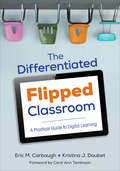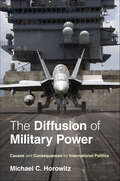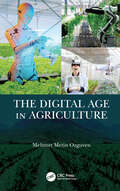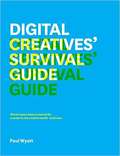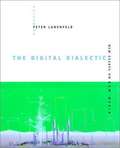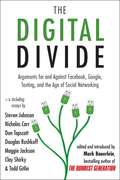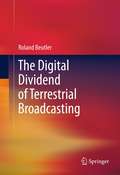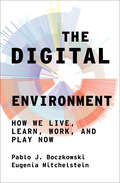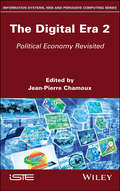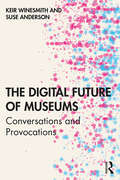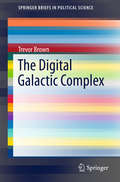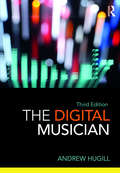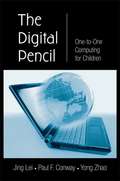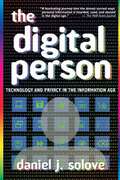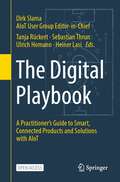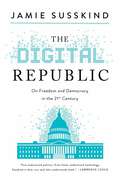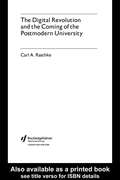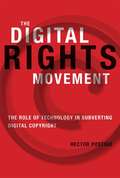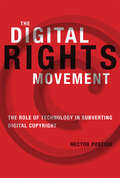- Table View
- List View
The Differentiated Flipped Classroom: A Practical Guide to Digital Learning (Corwin Teaching Essentials)
by Eric M. Carbaugh Kristina J. DoubetEnsure personalized student learning with this breakthrough approach to the Flipped Classroom! In the flipped classroom, students need to do more than simply re-watch a video to learn effectively. This groundbreaking guide helps you identify and address diverse student needs within the flipped classroom environment. You will find practical, standards-aligned solutions to help you design and implement carefully planned at-home and at-school learning experiences, all while checking for individual student understanding. Learn to differentiate learning for all students with structured, research-based best practices to help you: Integrate Flipped Learning and Differentiated Instruction Use technology as a meaningful learning tool Implement flexible planning and grouping Proactively use ongoing formative assessments Adjust instruction to support, challenge, and motivate diverse learners Manage the Differentiated Flipped classroom Includes practical examples and a resource-rich appendix. Make your flipped classroom a true place of learning with this go-to guide! "The expectations for teaching in today’s world are steadily increasing. Students expect their teachers to use technology in instruction. Parents and administrators expect teachers to differentiate instruction to reach every student. In this book you will learn how both models can work in concert. Even more importantly you will learn many practical strategies that will allow you to meaningfully differentiate your instruction while flipping your classroom, allowing you the greatest potential to reach all of your students." —David A. Slykhuis, PhD, President of SITE (The Society for Information Technology and Teacher Education)
The Differentiated Flipped Classroom: A Practical Guide to Digital Learning (Corwin Teaching Essentials)
by Eric M. Carbaugh Kristina J. DoubetEnsure personalized student learning with this breakthrough approach to the Flipped Classroom! In the flipped classroom, students need to do more than simply re-watch a video to learn effectively. This groundbreaking guide helps you identify and address diverse student needs within the flipped classroom environment. You will find practical, standards-aligned solutions to help you design and implement carefully planned at-home and at-school learning experiences, all while checking for individual student understanding. Learn to differentiate learning for all students with structured, research-based best practices to help you: Integrate Flipped Learning and Differentiated Instruction Use technology as a meaningful learning tool Implement flexible planning and grouping Proactively use ongoing formative assessments Adjust instruction to support, challenge, and motivate diverse learners Manage the Differentiated Flipped classroom Includes practical examples and a resource-rich appendix. Make your flipped classroom a true place of learning with this go-to guide! "The expectations for teaching in today’s world are steadily increasing. Students expect their teachers to use technology in instruction. Parents and administrators expect teachers to differentiate instruction to reach every student. In this book you will learn how both models can work in concert. Even more importantly you will learn many practical strategies that will allow you to meaningfully differentiate your instruction while flipping your classroom, allowing you the greatest potential to reach all of your students." —David A. Slykhuis, PhD, President of SITE (The Society for Information Technology and Teacher Education)
The Diffusion of Military Power: Causes and Consequences for International Politics
by Michael C. HorowitzThe Diffusion of Military Power examines how the financial and organizational challenges of adopting new methods of fighting wars can influence the international balance of power. Michael Horowitz argues that a state or actor wishing to adopt a military innovation must possess both the financial resources to buy or build the technology and the internal organizational capacity to accommodate any necessary changes in recruiting, training, or operations. How countries react to new innovations--and to other actors that do or don't adopt them--has profound implications for the global order and the likelihood of war. Horowitz looks at some of the most important military innovations throughout history, including the advent of the all-big-gun steel battleship, the development of aircraft carriers and nuclear weapons, and the use of suicide terror by nonstate actors. He shows how expensive innovations can favor wealthier, more powerful countries, but also how those same states often stumble when facing organizationally complicated innovations. Innovations requiring major upheavals in doctrine and organization can disadvantage the wealthiest states due to their bureaucratic inflexibility and weight the balance of power toward smaller and more nimble actors, making conflict more likely. This book provides vital insights into military innovations and their impact on U.S. foreign policy, warfare, and the distribution of power in the international system.
The Digital Age in Agriculture
by Mehmet Metin OzguvenThe Digital Age in Agriculture presents information related to the digital age in the agriculture sector. Agriculture is an essential activity for the continuity of life, yet is very labor-intensive and faces a wide variety of challenges. In the struggle against these difficulties, the superior features offered by technology provide important benefits. These technologies require expertise in various technical disciplines, and The Digital Age in Agriculture provides information to readers allowing them to make more informed decisions and giving them the opportunity to improve agricultural productivity. Written by Mehmet Metin Özgüven, an expert who has conducted field studies and with a working technical knowledge of various topics pertaining to the agriculture age, this book covers many subjects important to the age of digital agriculture, including precision agriculture and livestock farming, using agricultural robots and unmanned arial vehicles in agriculture practices, and image processing and machine vision. It is an essential read for researchers, agriculture sector workers, and agricultural engineers.
The Digital Creative's Survival Guide: Everything You Need for a Successful Career in Web, App, Multimedia and Broadcast Design
by Paul Wyatt<p>Take control of your digital media career! <p>When it comes to the web and mobile, only one thing is guaranteed, and that's change. If you're a creative working in this ever changing field and looking for answers, look no further. <p>The Digital Creative's Survival Guide gives you the insider's edge you need to stay inspired, informed, and employed. This must-have reference is packed with practical advice on topics like managing studio politics, dealing with nightmare clients, using good digital project management practices, understanding design briefs and finding your niche in a constantly changing industry. Within these pages, you'll discover: <p> <li>Interviews with successful creatives from around the world. <li>Deconstructions of digital design projects that worked. <li>Practical career information and advice for staying marketable and "future-proof." <li>And much more!</li> <p> <p>Showcasing the work and wisdom from some of the best digital creatives in the business today, The Digital Creative's Survival Guide is the tool you need to take control of your career and stay relevant no matter what happens in the industry.</p>
The Digital Currency Challenge: Shaping Online Payment Systems through US Financial Regulations (Palgrave Pivot)
by P. Carl Mullan<p>Private online digital currency systems offer people accessible, convenient, and inexpensive everyday financial tools outside of traditional bank-owned and operated platforms. Digital currency systems facilitate local and international fund transfers, online and offline payments, and simple cash-to-digital everyday financial products without the need for a conventional bank account of any retail bank product. Over the past several years, Bitcoin has grown into an efficient person-to-person and person-to-business payment system without the backing of any bank or financial institution. This phenomenon is producing a new level of an on- and offline commerce and a society much more attuned to digital currency systems. <p>The Digital Currency Challenge details how new 2007-2008 U.S. legal issues surrounding digital currency products forced companies from the U.S. market and caused the Treasury Department to enact stricter regulations. Mullan profiles new and innovative present day digital currency systems, such as Bitcoin, and illustrates how software designers and monetary theorists use new technology to circumvent current U.S. regulations. This work also explains how new digital currency systems are not just software products, but tools providing financial freedom to people in countries all around the world.</p>
The Digital Dialectic: New Essays On New Media
by Peter LunenfeldComputers linked to networks have created the first broadly used systems that allow individuals to create, distribute, and receive audiovisual content with the same box. They challenge theorists of digital culture to develop interaction-based models to replace the more primitive models that allow only passive use. The Digital Dialectic is an interdisciplinary jam session about our visual and intellectual cultures as the computer recodes technologies, media, and art forms. Unlike purely academic texts on new media, the book includes contributions by scholars, artists, and entrepreneurs, who combine theoretical investigations with hands-on analysis of the possibilities (and limitations) of new technology. The key concept is the digital dialectic: a method to ground the insights of theory in the constraints of practice. The essays move beyond journalistic reportage and hype into serious but accessible discussion of new technologies, new media, and new cultural forms.
The Digital Difference
by W. Russell NeumanW. Russell Neuman examines how the transition from the industrial-era media of one-way publishing and broadcasting to the two-way digital era of online search and social media has affected the dynamics of public life. The issues range from propaganda studies and Big Brother to information overload and Internet network neutrality.
The Digital Divide
by Mark BauerleinThis definitive work on the perils and promise of the social-media revolution collects writings by today's best thinkers and cultural commentators, with an all-new introduction by Bauerlein. Twitter, Facebook, e-publishing, blogs, distance-learning and other social media raise some of the most divisive cultural questions of our time. Some see the technological breakthroughs we live with as hopeful and democratic new steps in education, information gathering, and human progress. But others are deeply concerned by the eroding of civility online, declining reading habits, withering attention spans, and the treacherous effects of 24/7 peer pressure on our young. With The Dumbest Generation, Mark Bauerlein emerged as the foremost voice against the development of an overwhelming digital social culture. But The Digital Divide doesn't take sides. Framing the discussion so that leading voices from across the spectrum, supporters and detractors alike, have the opportunity to weigh in on the profound issues raised by the new media-from questions of reading skills and attention span, to cyber-bullying and the digital playground- Bauerlein's new book takes the debate to a higher ground. The book includes essays by Steven Johnson, Nicholas Carr, Don Tapscott, Douglas Rushkoff, Maggie Jackson, Clay Shirky, Todd Gitlin, and many more. Though these pieces have been previously published, the organization of The Digital Dividegives them freshness and new relevancy, making them part of a single document readers can use to truly get a handle on online privacy, the perils of a plugged-in childhood, and other technology-related hot topics. Rather than dividing the book into "pro" and "con" sections, the essays are arranged by subject-"The Brain, the Senses," "Learning in and out of the Classroom," "Social and Personal Life," "The Millennials," "The Fate of Culture," and "The Human (and Political) Impact." Bauerlein incorporates a short headnote and a capsule bio about each contributor, as well as relevant contextual information about the source of the selection. Bauerlein also provides a new introduction that traces the development of the debate, from the initial Digital Age zeal, to a wave of skepticism, and to a third stage of reflection that wavers between criticism and endorsement. Enthusiasms for the Digital Age has cooled with the passage of time and the piling up of real-life examples that prove the risks of an online-focused culture. However, there is still much debate, comprising thousands of commentaries and hundreds of books, about how these technologies are rewriting our futures. Now, with this timely and definitive volume, readers can finally cut through the clamor, read the the very best writings from each side of The Digital Divide, and make more informed decisions about the presence and place of technology in their lives.
The Digital Dividend of Terrestrial Broadcasting
by Roland BeutlerThe "digital revolution" of the last two decades has pervaded innumerable aspects of our daily lives and changed our planet irreversibly. The shift from analog to digital broadcasting has facilitated a seemingly infinite variety of new applications--audience interactivity being but one example. The greater efficiency and compression of digital media have endowed broadcasters with a "digital dividend" of spare transmission capacity over and above the requirements of terrestrial broadcasting. The question is, who will use it, and how? Comparing the European experience with that of broadcasters elsewhere in the world, the author sketches the current status of international frequency management, quantifies the value of the "dividend" itself, analyzes the details of the analog-to-digital switchovers already completed, and posits what the future holds for the sector. As we grapple with new devices, inconceivable a mere generation ago, that allow us to access digital media instantly, anywhere and at any time of day, this book is a potent reminder that what we have witnessed so far may be just the first wavering steps along a road whose destination we can only guess at.
The Digital Enterprise
by Kay HenningFirst published in 1999, The Digital Enterprise gives the historical context which gave rise to the digital industry, assesses the key sectors of the industry and outlines new business opportunities in the media, the entertainments business and the retail sector. It describes the challenges to business and how these can be met, and also looks to the digital future.
The Digital Environment: How We Live, Learn, Work, and Play Now
by Pablo J. Boczkowski Eugenia MitchelsteinUnderstanding digital technology in daily life: why we should think holistically in terms of a digital environment instead of discrete devices and apps.Increasingly we live through our personal screens; we work, play, socialize, and learn digitally. The shift to remote everything during the pandemic was another step in a decades-long march toward the digitization of everyday life made possible by innovations in media, information, and communication technology. In The Digital Environment, Pablo Boczkowski and Eugenia Mitchelstein offer a new way to understand the role of the digital in our daily lives, calling on us to turn our attention from our discrete devices and apps to the array of artifacts and practices that make up the digital environment that envelops every aspect of our social experience. Boczkowski and Mitchelstein explore a series of issues raised by the digital takeover of everyday life, drawing on interviews with a variety of experts. They show how existing inequities of gender, race, ethnicity, education, and class are baked into the design and deployment of technology, and describe emancipatory practices that counter this--including the use of Twitter as a platform for activism through such hashtags as #BlackLivesMatter and #MeToo. They discuss the digitization of parenting, schooling, and dating--noting, among other things, that today we can both begin and end relationships online. They describe how digital media shape our consumption of sports, entertainment, and news, and consider the dynamics of political campaigns, disinformation, and social activism. Finally, they report on developments in three areas that will be key to our digital future: data science, virtual reality, and space exploration.
The Digital Era 2: Political Economy Revisited
by Jean-Pierre ChamouxFor 200 years, industry mastered iron, fire, strength and energy. Today, electronics shape our everyday objects, integrating chips everywhere: computers, phones, keys, games, household appliances, etc. Data, software and calculation frame the conduct of men and the administration of things. Everything is translated into data: the figure is king. The second volume of this series describes how the digital economy transforms market relations and why this change puts political economy to the test.
The Digital Future of Museums: Conversations and Provocations
by Keir Winesmith Suse AndersonThe Digital Future of Museums: Conversations and Provocations argues that museums today can neither ignore the importance of digital technologies when engaging their communities, nor fail to address the broader social, economic and cultural changes that shape their digital offerings. Through moderated conversations with respected and inf luential museum practitioners, thinkers and experts in related fields, this book explores the role of digital technology in contemporary museum practice within Europe, the U.S., Australasia and Asia. It offers provocations and reflections about effective practice that will help prepare today’s museums for tomorrow, culminating in a set of competing possible visions for the future of the museum sector. The Digital Future of Museums is essential reading for museum studies students and those who teach or write about the museum sector. It will also be of interest to those who work in, for, and with museums, as well as practitioners working in galleries, archives and libraries.
The Digital Galactic Complex
by Trevor BrownThis Brief discusses the current policy environment in which the United States space program operates and proposes an industry-government partnership as a long-term policy solution. Since the Reagan administration, American space policy has increasingly sought to involve private sector operators for space. The culmination of this trend has been the Obama administration's policy of private sector transportation of crew and cargo to the International Space Station on behalf of NASA. This book proposes that future administrations extend this policy to other areas of space, including energy, in orbit manufacturing, asteroid mining, and the exploration of the Moon and Mars. The book further demonstrates how these activities can stabilize the global political system and lead to a dramatic increase in global economic growth. Finally, the book addresses one of the most important and critical issues currently facing humanity--the need for a viable, baseload, and unlimited supply of totally clean energy. An extremely cogent analysis of the interrelationship between space activity and the terrestrial economy, this book showcases the political and economic potential of the medium of space and adds greatly to the existing literature in the field. This book will be of interest to students of political science and strategic studies as well as members of the military, government space agencies, and the international aerospace industry.
The Digital Humanities
by Gardiner, Eileen and Musto, Ronald G. Eileen Gardiner Ronald G. MustoThe Digital Humanities is a comprehensive introduction and practical guide to how humanists use the digital to conduct research, organize materials, analyze, and publish findings. It summarizes the turn toward the digital that is reinventing every aspect of the humanities among scholars, libraries, publishers, administrators, and the public. Beginning with some definitions and a brief historical survey of the humanities, the book examines how humanists work, what they study, and how humanists and their research have been impacted by the digital and how, in turn, they shape it. It surveys digital humanities tools and their functions, the digital humanists' environments, and the outcomes and reception of their work. The book pays particular attention to both theoretical underpinnings and practical considerations for embarking on digital humanities projects. It places the digital humanities firmly within the historical traditions of the humanities and in the contexts of current academic and scholarly life.
The Digital Musician (Third Edition)
by Andrew Hugill<p>The Digital Musician, Third Edition is an introductory textbook for creative music technology and electronic music courses. Written to be accessible to students from any musical background, this book examines cultural awareness, artistic identity and musical skills, offering a system-agnostic survey of digital music creation. Each chapter presents creative projects that reinforce concepts, as well as case studies of real musicians and discussion questions for further reflection. <p>This third edition has been updated to reflect developments in an ever-changing musical landscape―most notably the proliferation of mobile technologies―covering topics such as collaborative composition, virtual reality, data sonification and digital scores, while encouraging readers to adapt to continuous technological changes. With an emphasis on discovering one’s musical voice and identity, and tools and ideas that are relevant in any musical situation, The Digital Musician is sure to be an invaluable student resource for years to come.</p>
The Digital Pencil: One-to-One Computing for Children
by Jing LeiThis book takes a serious historical and international look at the "digital pencil" movement to equip every student with a computing device with wireless connection. Using an ecological perspective as an overarching framework, and drawing on their own studies and available literature that illuminate the issues related to one-to-one computing, the a
The Digital Person: Technology and Privacy in the Information Age (Ex Machina: Law, Technology, and Society #1)
by Daniel J SoloveA startling account of personal data dossiers and the newest grave threat to privacySeven days a week, twenty-four hours a day, electronic databases are compiling information about you. As you surf the Internet, an unprecedented amount of your personal information is being recorded and preserved forever in the digital minds of computers. For each individual, these databases create a profile of activities, interests, and preferences used to investigate backgrounds, check credit, market products, and make a wide variety of decisions affecting our lives. The creation and use of these databases—which Daniel J. Solove calls “digital dossiers”—has thus far gone largely unchecked. In this startling account of new technologies for gathering and using personal data, Solove explains why digital dossiers pose a grave threat to our privacy.The Digital Person sets forth a new understanding of what privacy is, one that is appropriate for the new challenges of the Information Age. Solove recommends how the law can be reformed to simultaneously protect our privacy and allow us to enjoy the benefits of our increasingly digital world.This is the first volume in the series EX MACHINA: LAW, TECHNOLOGY, AND SOCIETY.
The Digital Playbook: A Practitioner’s Guide to Smart, Connected Products and Solutions with AIoT
by Dirk Slama Sebastian Thrun Tanja Rückert Ulrich Homann Heiner LasiThis open access book is a practitioner's guide to smart, connected products and solutions. As a hands-on playbook, it combines the business and technical execution perspectives to help product companies, OEMs, manufacturers and equipment operators utilize the full potential of digital enablers, especially Artificial Intelligence (AI), Internet of Things (IoT) and Digital Twins. The Digital Playbook provides comprehensive and actionable guidance, helping to address the challenges of creating sustainable and scalable digital business models, managing cocreation and sourcing, setting up the digital organization, and handling the legal aspects. For the technical execution perspective, the playbook includes the AIoT Framework, which explains how to combine data science and AI engineering with Digital Twins, as well as software development for cloud and edge. The integration with physical product development and retrofit integration of existing equipment is included as well. A pragmatic, agile approach is introduced that takes common agile inhibitors into consideration. A holistic AIoT DevOps approach is described, which combines key elements of DevOps for cloud, edge and AI. Enterprise readiness is ensured by looking at trust and security as well as reliability and resilience for AIoT. A large number of real-world examples and case studies help ensure practical relevance. Readers should have a previous, general understanding of digital strategies and technologies. This book offers readers a clear understanding of the opportunities, as well as the challenges related to building and operating smart, connected products and solutions. They are given a set of tools and blueprints, which they can apply to their practical work in this space.
The Digital Public Domain: Foundations for an Open Culture
by Melanie Dulong de Rosnay and Juan Carlos De MartinDigital technology has made culture more accessible than ever before. Texts, audio, pictures and video can easily be produced, disseminated, used and remixed using devices that are increasingly user-friendly and affordable. However, along with this technological democratization comes a paradoxical flipside: the norms regulating culture's use—copyright and related rights—have become increasingly restrictive. <p><p> This book brings together essays by academics, librarians, entrepreneurs, activists and policy makers, who were all part of the EU-funded Communia project. Together the authors argue that the Public Domain—that is, the informational works owned by all of us, be that literature, music, the output of scientific research, educational material or public sector information—is fundamental to a healthy society. <p> The essays range from more theoretical papers on the history of copyright and the Public Domain, to practical examples and case studies of recent projects that have engaged with the principles of Open Access and Creative Commons licensing. The book is essential reading for anyone interested in the current debate about copyright and the Internet. It opens up discussion and offers practical solutions to the difficult question of the regulation of culture at the digital age.
The Digital Republic: On Freedom and Democracy in the 21st Century
by Jamie SusskindFrom one of the leading intellectuals of the digital age, The Digital Republic is the definitive guide to the great political question of our time: how can freedom and democracy survive in a world of powerful digital technologies?A Financial Times &“Book to Read&” in 2022 Not long ago, the tech industry was widely admired, and the internet was regarded as a tonic for freedom and democracy. Not anymore. Every day, the headlines blaze with reports of racist algorithms, data leaks, and social media platforms festering with falsehood and hate. In The Digital Republic, acclaimed author Jamie Susskind argues that these problems are not the fault of a few bad apples at the top of the industry. They are the result of our failure to govern technology properly. The Digital Republic charts a new course. It offers a plan for the digital age: new legal standards, new public bodies and institutions, new duties on platforms, new rights and regulators, new codes of conduct for people in the tech industry. Inspired by the great political essays of the past, and steeped in the traditions of republican thought, it offers a vision of a different type of society: a digital republic in which human and technological flourishing go hand in hand.
The Digital Revolution and the Coming of the Postmodern University
by Carl A. RaschkeIn recent years, the powerful social, cultural and economic changes wrought by digital technology have led many to forecast the end of the university as we know it. This book employs extensive research and case studies to explain why these predictions, even if perhaps somewhat premature, are on solid ground.The Digital Revolution and the Coming of the Postmodern University shows how the internet, high-speed electronic communications and personal computers necessitate a radical rethinking of what is meant by 'higher education'. The book calls into question both the traditionalist's scepticism about the benefits of new technology, and the corporate e-learning advocate's failure to grasp that education is more than what happens on a computer screen. The author provides concrete data and models for more democratic, restructured systems of instruction that not only take advantage of advanced learning technologies, but promote the globalisation of higher education.This is an essential read for anyone concerned about the future of higher education.
The Digital Rights Movement
by Hector PostigoThe movement against restrictive digital copyright protection arose largely in response to the excesses of the Digital Millennium Copyright Act (DMCA) of 1998. In The Digital Rights Movement, Hector Postigo shows that what began as an assertion of consumer rights to digital content has become something broader: a movement concerned not just with consumers and gadgets but with cultural ownership. Increasingly stringent laws and technological measures are more than incoveniences; they lock up access to our "cultural commons. " Postigo describes the legislative history of the DMCA and how policy "blind spots" produced a law at odds with existing and emerging consumer practices. Yet the DMCA established a political and legal rationale brought to bear on digital media, the Internet, and other new technologies. Drawing on social movement theory and science and technology studies, Postigo presents case studies of resistance to increased control over digital media, describing a host of tactics that range from hacking to lobbying. Postigo discusses the movement's new, user-centered conception of "fair use" that seeks to legitimize noncommercial personal and creative uses such as copying legitimately purchased content and remixing music and video tracks. He introduces the concept of technological resistance--when hackers and users design and deploy technologies that allows access to digital content despite technological protection mechanisms--as the flip side to the technological enforcement represented by digital copy protection and a crucial tactic for the movement.
The Digital Rights Movement: The Role of Technology in Subverting Digital Copyright (The Information Society Series)
by Hector PostigoThe evolution of activism against the expansion of copyright in the digital domain, with case studies of resistance including eBook and iTunes hacks.The movement against restrictive digital copyright protection arose largely in response to the excesses of the Digital Millennium Copyright Act (DMCA) of 1998. In The Digital Rights Movement, Hector Postigo shows that what began as an assertion of consumer rights to digital content has become something broader: a movement concerned not just with consumers and gadgets but with cultural ownership. Increasingly stringent laws and technological measures are more than incoveniences; they lock up access to our “cultural commons.”Postigo describes the legislative history of the DMCA and how policy “blind spots” produced a law at odds with existing and emerging consumer practices. Yet the DMCA established a political and legal rationale brought to bear on digital media, the Internet, and other new technologies. Drawing on social movement theory and science and technology studies, Postigo presents case studies of resistance to increased control over digital media, describing a host of tactics that range from hacking to lobbying.Postigo discusses the movement's new, user-centered conception of “fair use” that seeks to legitimize noncommercial personal and creative uses such as copying legitimately purchased content and remixing music and video tracks. He introduces the concept of technological resistance—when hackers and users design and deploy technologies that allows access to digital content despite technological protection mechanisms—as the flip side to the technological enforcement represented by digital copy protection and a crucial tactic for the movement.
